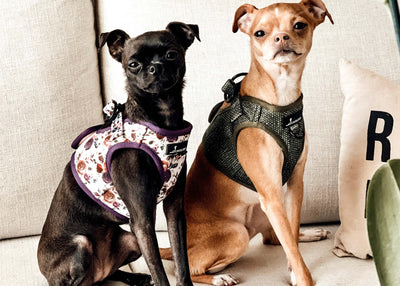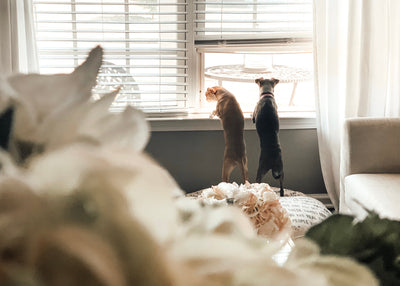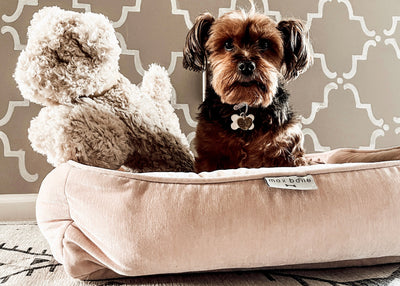Introducing a Second Dog? How to Help Your First Pup Love the Upgrade

So getting a dog for your dog is totally a thing. If you're a veteran dog mom then you already know some pups just need their own fur baby. There are dogs who are totally fine with being the center of your universe and having all of your attention. As a matter of fact, some prefer things that way.
But there are also those who light up whenever they see another canine. The dog park is their happy place and having a constant companion is their #lifegoals.
So if you decided to bring home a new dog, how do you go about doing it? Is there some sort of secret formula for doggy introductions? Is there a conversation that you need to have with your dog first? As a dog mom who has brought many a dog home, I do have some tips to share on what worked for me. So, let's chat.
Is My Dog Social?
So here's the first question you need to settle: is your fur baby social? And let me tell you this right now. If your fur kid does not play well with others then that is totally your fault. Now I'm not saying that every dog needs a furry roommate. But I am saying that your fur baby should have some basic manners.
That means you should be able to introduce new people to your dog without a snarl marathon. New hoomans should not have to brace for impact every five seconds. Or, if you're introducing your dog to a furry friend, they should know Dog Greeting 101 Etiquette. So no aggressive leash pulling or angry barking at new fur kids. We do not bite new fur kids! No!
If your dog cannot greet new hoomans or other dogs in a calm friendly way, then you have some work to do. The causes for this sort of disruptive behavior can vary widely. Oftentimes these episodes are triggered by fear. In other cases it could be a lack of boundaries. And in still others, it can be a territorial type display.

Going to School
Whatever the case, the first step is formal training. And brace yourself. That training is more to retrain you than your fur kid. Dogs act out because we either reinforce destructive behavior or welcome it through a lack of boundaries. Remember, naturally dogs have pack leaders who set the rules. If you aren't the pack leader setting the rules, then your dog will either become anxious due to the chaos, or will set some rules of their own.
Here are some signs that you do not have any doggy boundaries:
- Does your dog pull when on leash?
- Does your dog push past you when you open doors?
- Does your dog come or stay on command?
- Does your dog bark, whine or beg when you are eating?
- Does your dog jump on your or your guests at unwelcomed times?
Time for Reinforcements
These are just some ideas to level set but you get the idea. So where can you go for help? This is a great time to once again use your resources. Check with your veterinarian about obedience training. Pet kennels often offer training classes or have connections to pet trainers. You can even check with large pet supply companies like PetSmart or Petco.
For additional tips on how to choose a dog trainer, please see the following articles:
Choosing a Great Dog Trainer 101 from The American Kennel Club
https://www.akc.org/expert-advice/training/choosing-a-dog-trainer/
Cesar's Five Rules for Choosing a Dog Trainer from Cesar Millan
https://www.cesarsway.com/cesars-5-rules-for-choosing-a-dog-trainer/
A Guide to Choosing the Best Dog Trainer for You AND Your Dog from Whole Dog Journal

Socializing Your Dog
Once you and your dog have come to an understanding, you will need to practice doggie introductions. The sooner your start this process the better. So if you have a puppy begin introducing them to new dogs and people as early as safely possible. Just be mindful not to start socialization training until they have completed all of their puppy shots.
The more experiences your dog has outside of the home, meeting new people and other dogs, the more comfortable they will become. When Coco was a puppy, as soon as he finished his puppy shots, he was out and about with me everywhere. Walks, dog parks, outdoor shopping centers and beaches were all part of his training. And the great thing is the other older dogs he met taught him the proper way to say hello in the dog world. (Let the booty sniffing begin!)
An important tip for new dog moms here is to make sure that your dog has mastered how to come to you on command before going to dog parks. It's important that both of you have great self control before you let your little one off leash in public.
Another great socialization tip is to arrange for puppy playdates at your home. It's one thing for your dog to greet a stranger on neutral ground. But it's a whole other ballgame when your dog is on his turf.
In the past when Coco did not have any siblings, I have arranged for playdates and even puppy sleepovers from time to time. One of the hardest things to do as a dog mom is leaving your fur baby in a kennel when you are traveling. So these puppy sleepovers were mutually beneficial.
It gave my fellow dog moms great peace of mind knowing their fur kid would be spending time with me instead of alone in a kennel. And it gave Coco and I the chance to experiment with a two dog household for a few days.*
*Sidenote: if you find a great kennel that your dog likes, you had found an amazing thing. So enjoy.
Welcome Home New Dog
There are endless reasons why dog moms decide to add a dog to their family. You may feel like your dog is lonely. Maybe you want him to have a friend around while you are at work. Dogs are pack animals. So it really isn't natural for a dog to be left alone for hours.
That said, you will still want to consider a few things. What is the temperament of your dog? Is he high strung or low key? You'll want the new dog's personality to compliment your current dog's.
You'll also want to keep dog sizes in mind. It's usually safe to bring a puppy of a larger breed home to a smaller dog. But it may not be as easy to bring an adult german shepherd to a teacup yorkie. I mean it's possible, but there's going to be a lot of work and supervision.
Ideally, you would want to arrange for your dog to meet their new sibling ahead of time. A couple of playdates before bringing the new dog home will help to make the transition easier.
But if you cannot do that, be sure to supervise the initial greeting. Have some designated areas in your home for either dog to have some alone time. Having a new dog around is highly stimulating and either dog may need some time to decompress.
Daily Life
As your dogs learn to live together, know that it will take some time to work out their relationship. Yes, some dogs are immediately best friends. But other dogs may need a little while to warm up.
While they figure things out, make sure they do not become territorial over toys, beds or food. Keep meal times structured. Do not let them eat out of the same bowl or steal food from each other.
Bedtime is very similar. Especially early on, everyone needs their own space at night. As time goes by, your dogs will set up their own boundaries with each other.
Daily walks together are not only great exercise but excellent pack bonding times. However, do make sure to continue to enforce good dog etiquette when other pooches approach. No dog mom wants to have her fur kids turn into a couple block bullies. So make sure you retain your tile as the head...BABE in charge.
Well that's it, BABE! Congratulations on your new squad member! Know that your first dog will be there to help you teach your new dog the ropes. And with that kind of of help, you all will be on the same page in no time!
Do you have any tips on how to add a new dog to your squad? If so, share them below!


![Is Now a Good Time for Me to Get a Dog or Puppy? [Things to Consider]](http://lindseyandcoco.com/cdn/shop/articles/Paris_and_Lindsey_400x.jpeg?v=1593125675)
![So You Brought Home a New Dog...Now What? [Tips for the Transition to Dog Ownership]](http://lindseyandcoco.com/cdn/shop/articles/Welcome_Home_Paris_a751f494-1e64-4fd4-976d-ec5c2471b843_400x.jpeg?v=1593283799)


![Helicopter Dog Moms Prepare For Take Off [6 Ways To Ease Your Return To Office]](http://lindseyandcoco.com/cdn/shop/articles/015708F9-341A-4EA5-9251-A33F5D4342AA_400x.jpg?v=1628705258)

![How To Care For A Dog With Sensitive Skin [Common Causes For Itchy Skin In Dogs]](http://lindseyandcoco.com/cdn/shop/articles/6FDB9B87-AF4E-4FE7-85BA-2D47B384F4C2_400x.jpg?v=1641586721)
![How To Work From Home With Multiple Dogs [And Stay Employed]](http://lindseyandcoco.com/cdn/shop/articles/IMG_6840_c04a5036-f3e9-44c7-92b2-bcdf8c34b857_400x.jpg?v=1749734000)